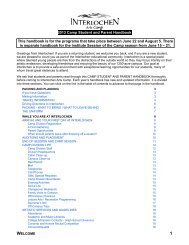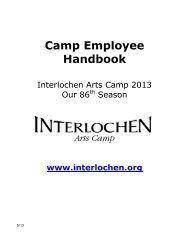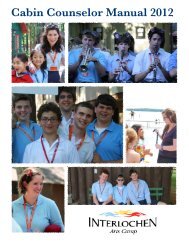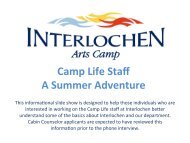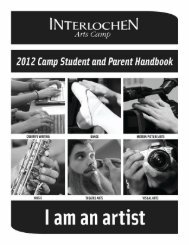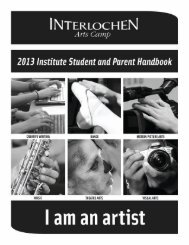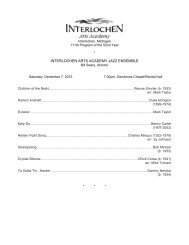Cabin Counselor Manual 2013 Final - Interlochen Center for the Arts
Cabin Counselor Manual 2013 Final - Interlochen Center for the Arts
Cabin Counselor Manual 2013 Final - Interlochen Center for the Arts
Create successful ePaper yourself
Turn your PDF publications into a flip-book with our unique Google optimized e-Paper software.
Teaching Appropriate Behavior<br />
Planned teaching sequence:<br />
1. Introduce skill to be learned.<br />
2. Describe appropriate behavior.<br />
3. Give rationale.<br />
• “It’s important to follow instructions because you may have more time to do what you choose to do.”<br />
• “When you get <strong>the</strong> counselor’s attention appropriately, you’re more likely to get <strong>the</strong> help you need<br />
quickly.”<br />
4. Request acknowledgement.<br />
5. Practice.<br />
6. Provide feedback.<br />
7. Provide positive rein<strong>for</strong>cement or consequence <strong>for</strong> learning.<br />
8. Establish future follow-up practice.<br />
Positive Rein<strong>for</strong>cement through Effective Praise<br />
Praise is contingent on appropriate behavior.<br />
Should be given in a timely manner, i.e., as soon as appropriate behavior has occurred.<br />
Specific description of appropriate behavior. Explain to <strong>the</strong>m what <strong>the</strong>y did correctly so <strong>the</strong>y may do it again.<br />
Make your statement credible.<br />
Praise small steps toward a goal.<br />
4:1 ratio of praise to correction.<br />
Be aware of your proximity to <strong>the</strong> camper when praising.<br />
Be aware of your body language as you are praising.<br />
Use variety.<br />
Praising is not offering a reward <strong>for</strong> doing something correct; it is acknowledging that a correct choice was made.<br />
Corrective Teaching<br />
Corrective teaching is your response to campers’ problem behaviors and involves teaching and practicing an appropriate<br />
replacement behavior.<br />
Corrective teaching is best used when campers are doing something you have asked <strong>the</strong>m not to do, not doing something<br />
that you have asked <strong>the</strong>m to do, or doing something that could harm <strong>the</strong>mselves or o<strong>the</strong>rs.<br />
Corrective teaching is a structured and predictable way to handle misbehavior while also providing a plan and<br />
replacement behavior <strong>for</strong> <strong>the</strong> future.<br />
Hints <strong>for</strong> Using Corrective Teaching<br />
Remain calm.<br />
Stick to one issue at a time.<br />
Give your campers <strong>the</strong> chance to earn something back (earn back up to half of what <strong>the</strong>y have lost).<br />
Be consistent with expectations and consequences.<br />
Handle <strong>the</strong> feelings first (yours and <strong>the</strong>irs) and <strong>the</strong> teaching second.<br />
Corrective Teaching Steps<br />
1. Stop <strong>the</strong> problem behavior.<br />
Get <strong>the</strong>ir attention.<br />
Specifically and calmly describe <strong>the</strong>ir behavior.<br />
Give short, clear instructions.<br />
2. Deliver Consequences<br />
Be consistent.<br />
Relate <strong>the</strong> consequences to <strong>the</strong> behavior.<br />
3. Teach Alternative Behaviors<br />
Teach a new behavior or skill.<br />
4. Practice Alternative Behaviors<br />
Have <strong>the</strong>m show you how to correctly respond.<br />
Praise <strong>the</strong>ir ef<strong>for</strong>ts.<br />
16



